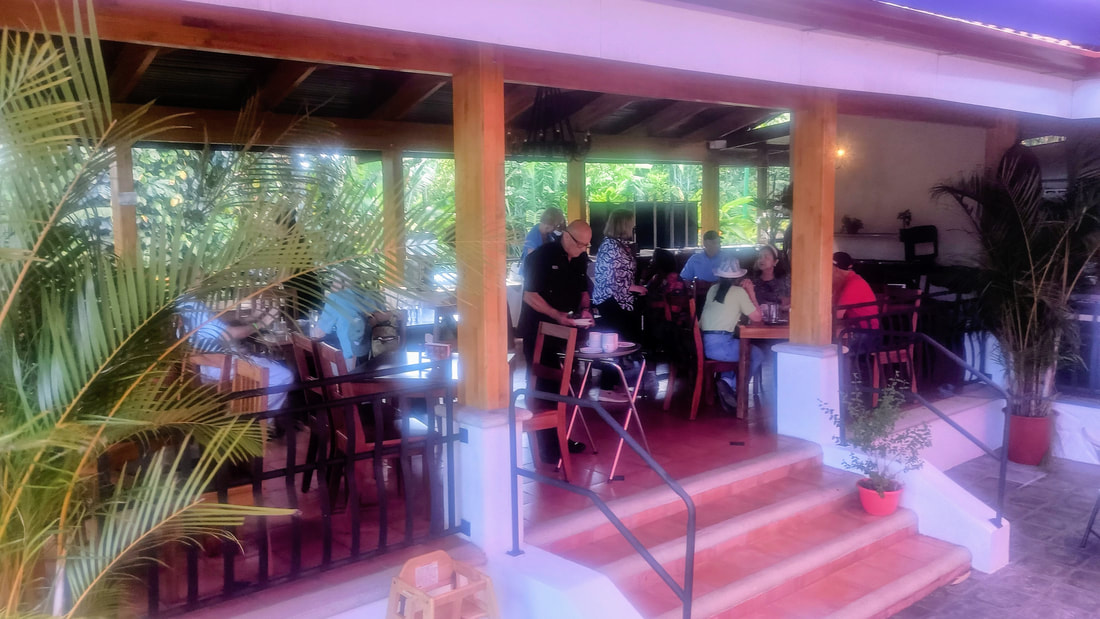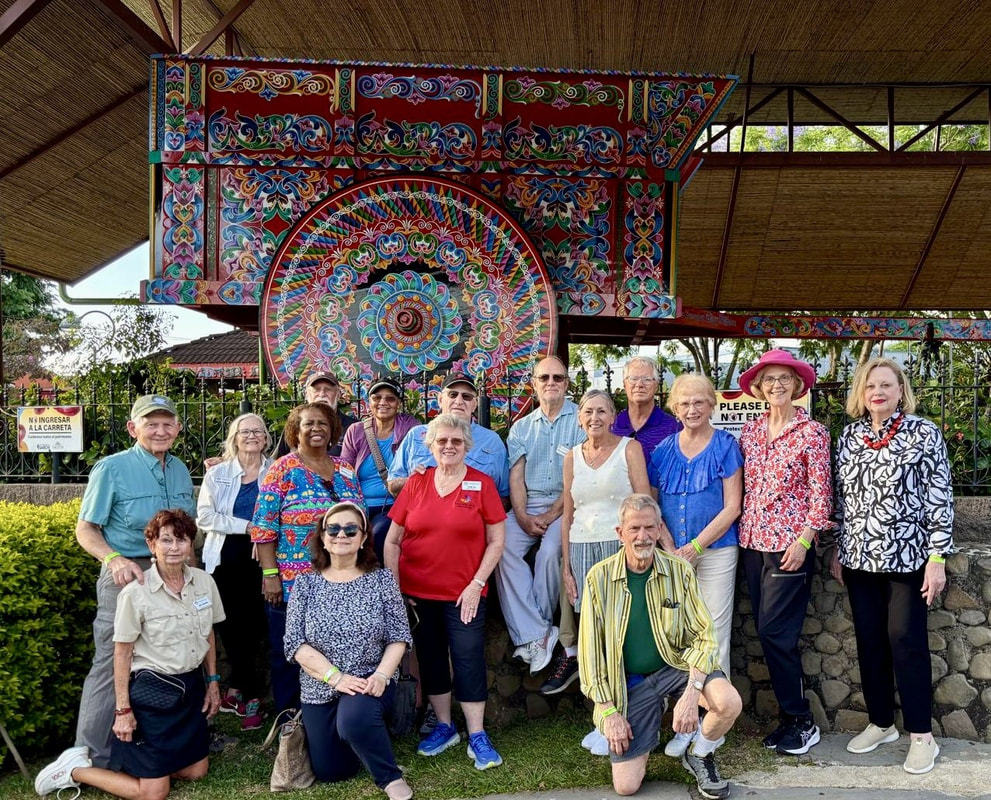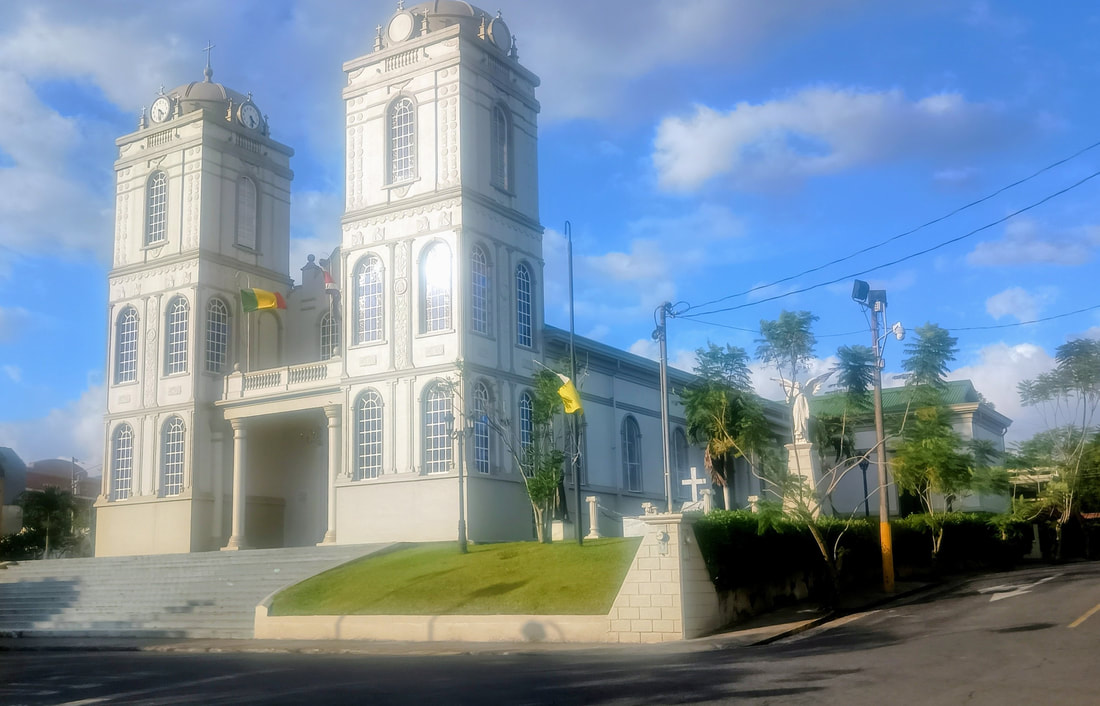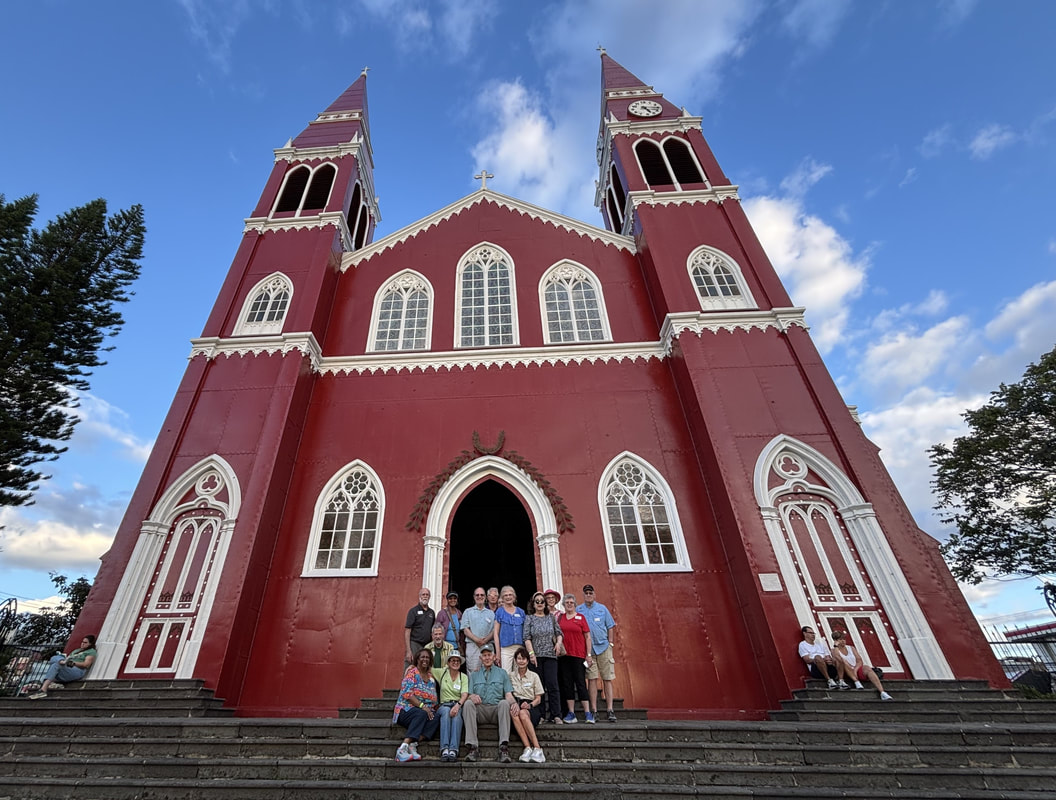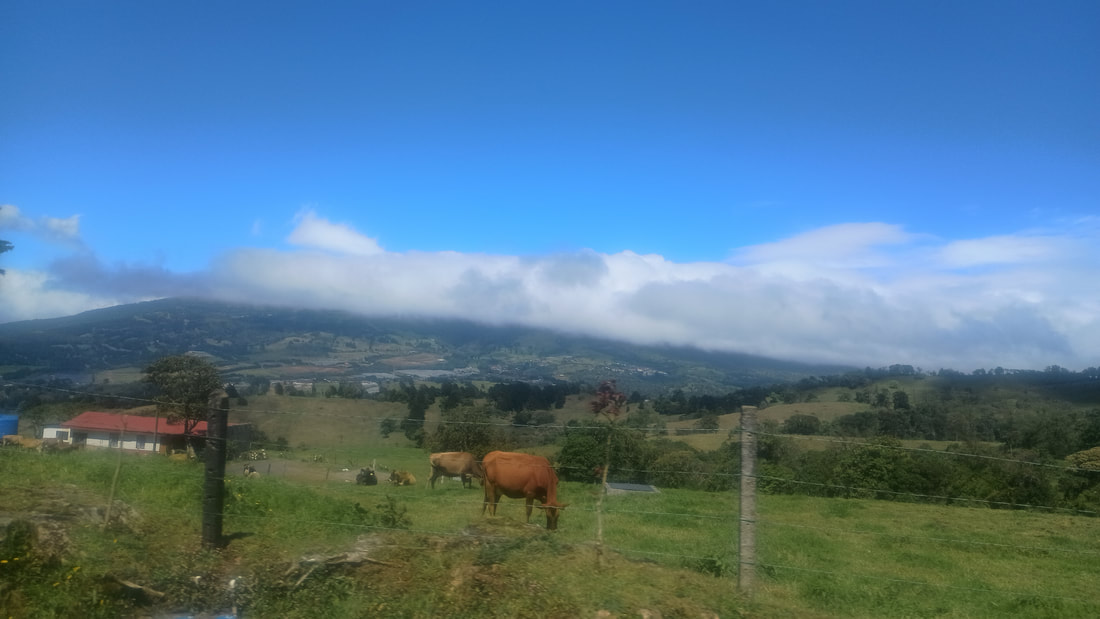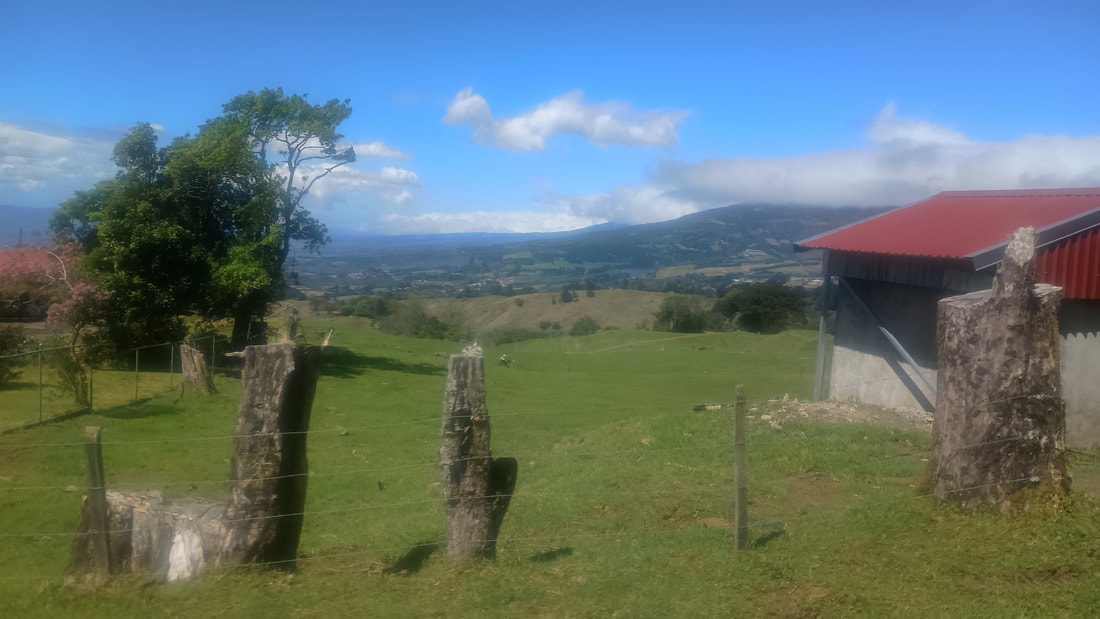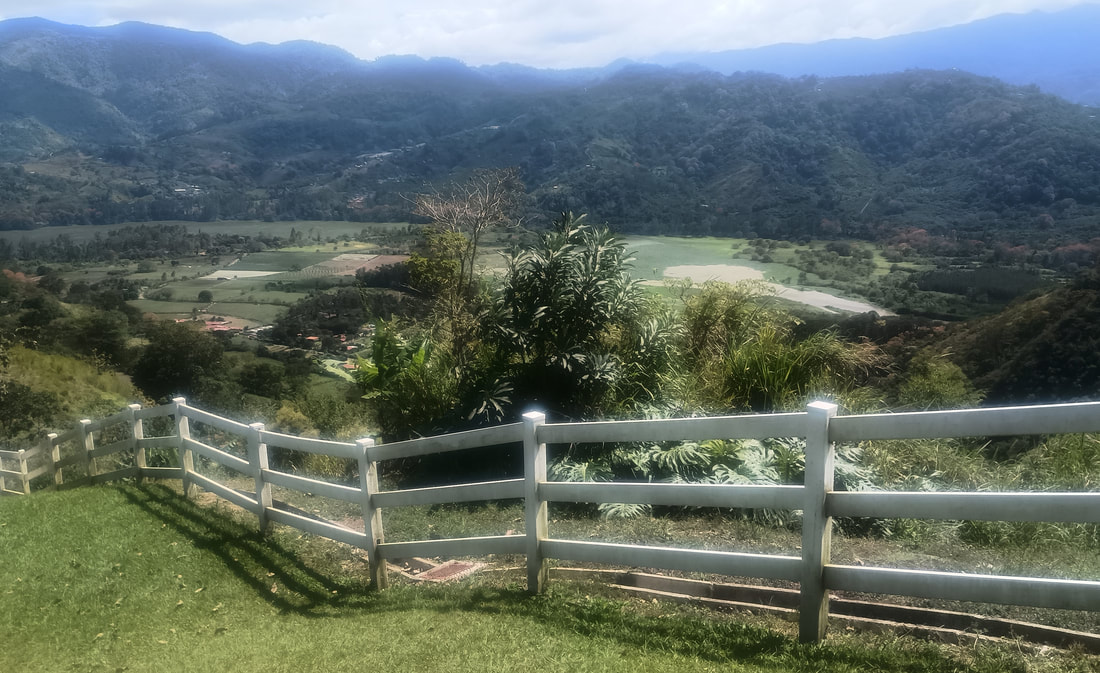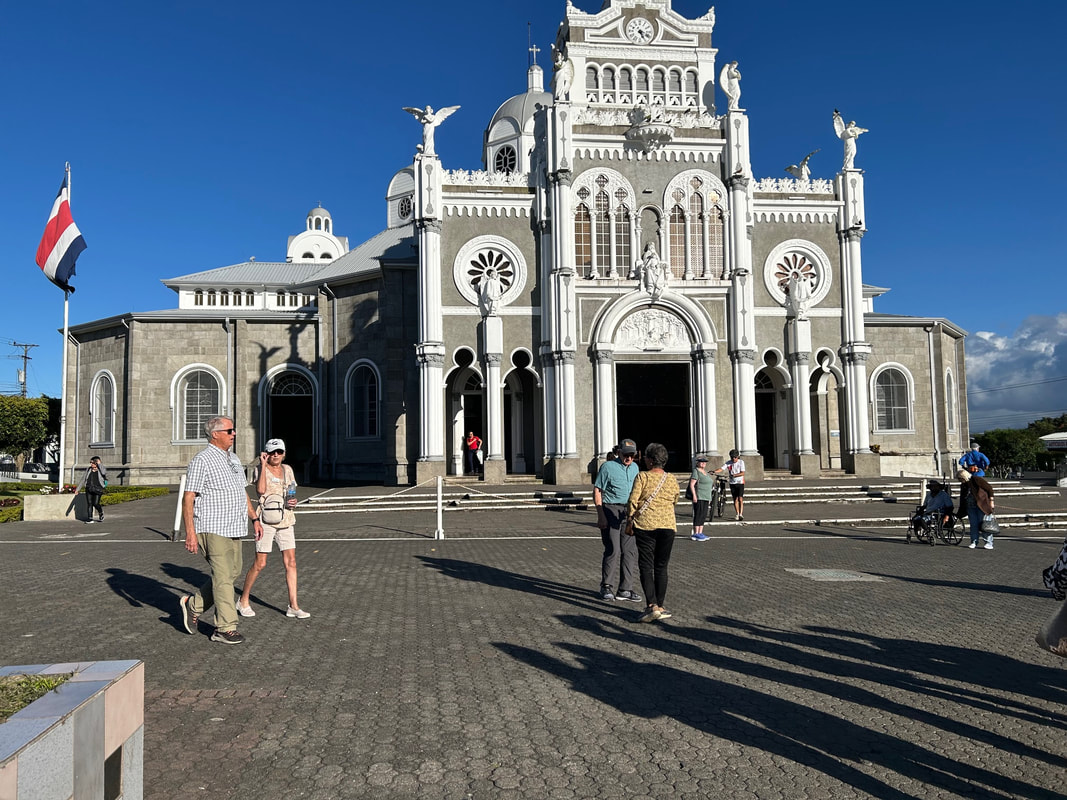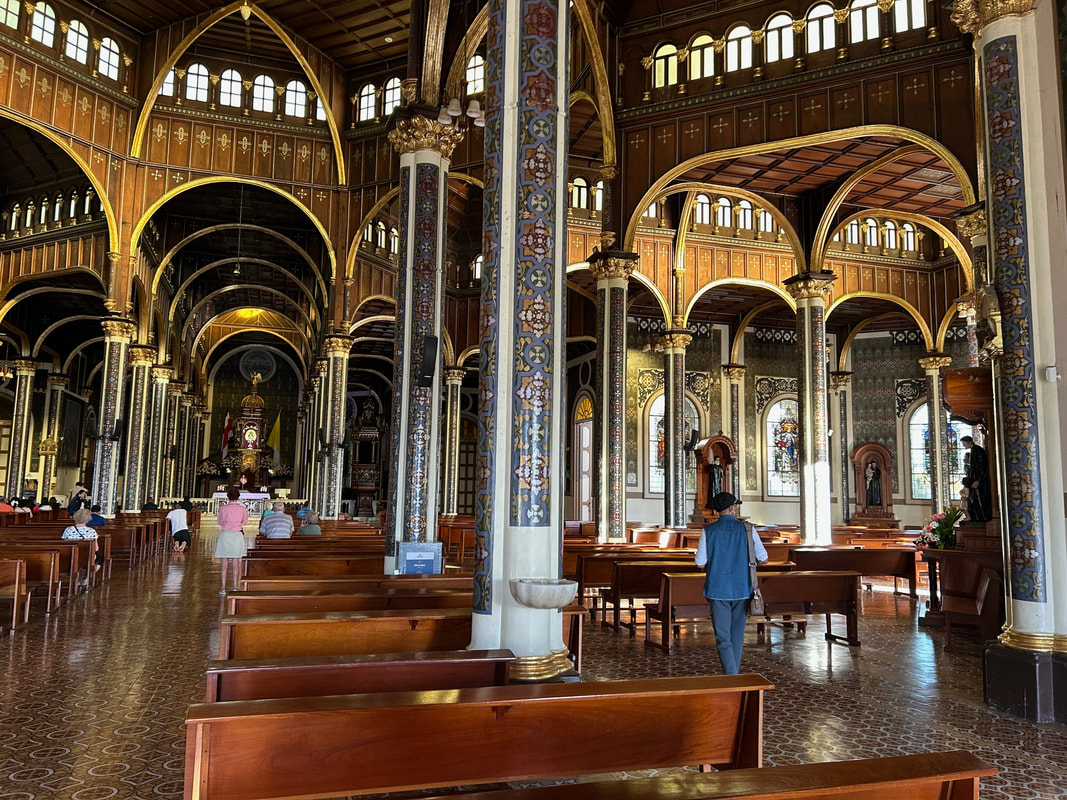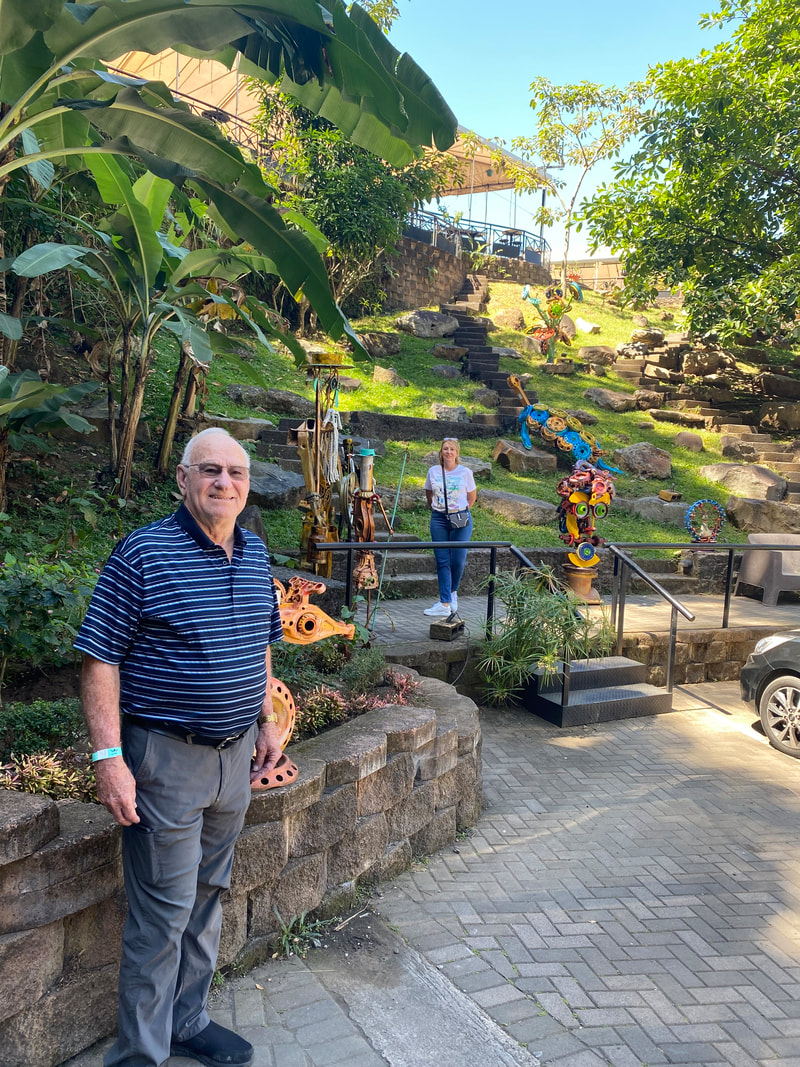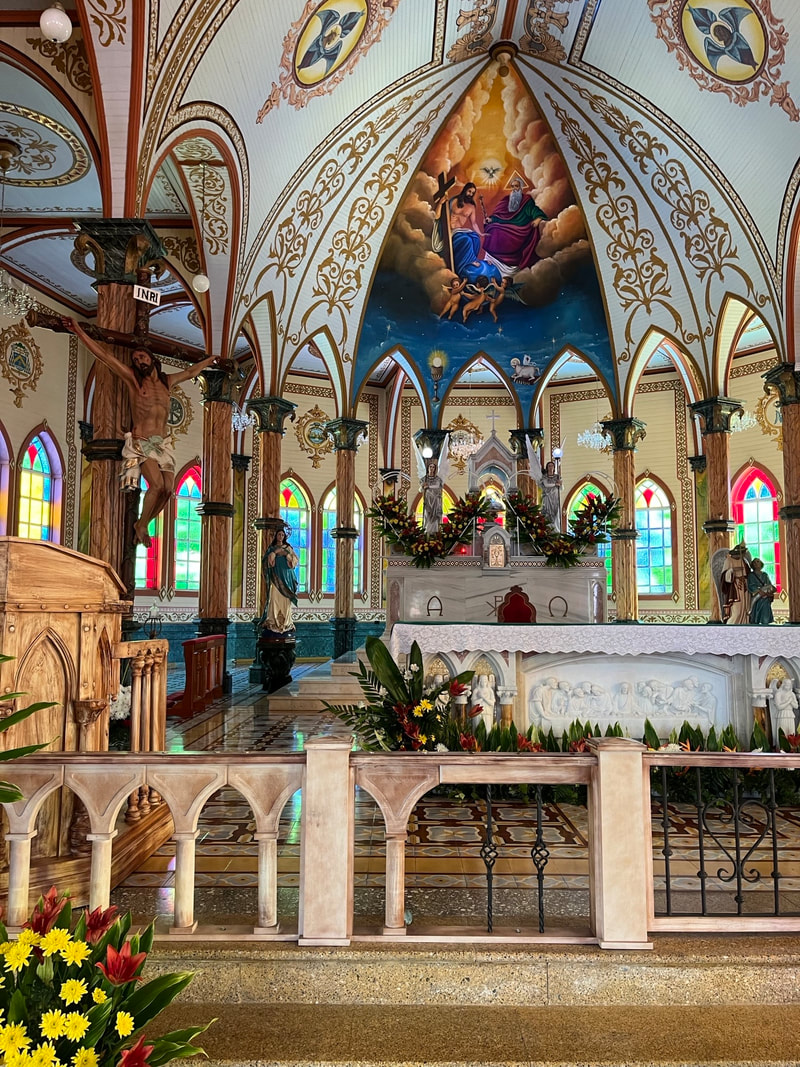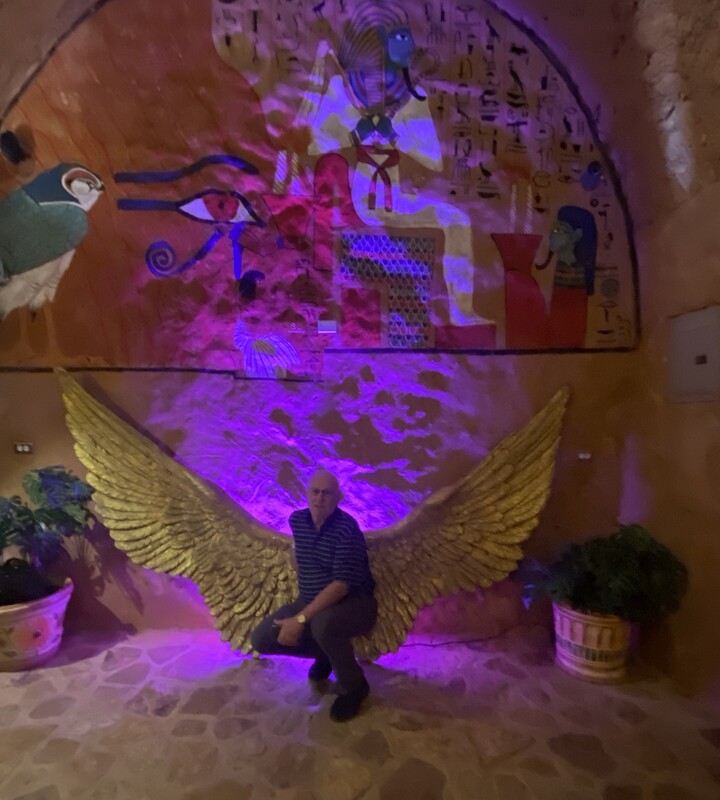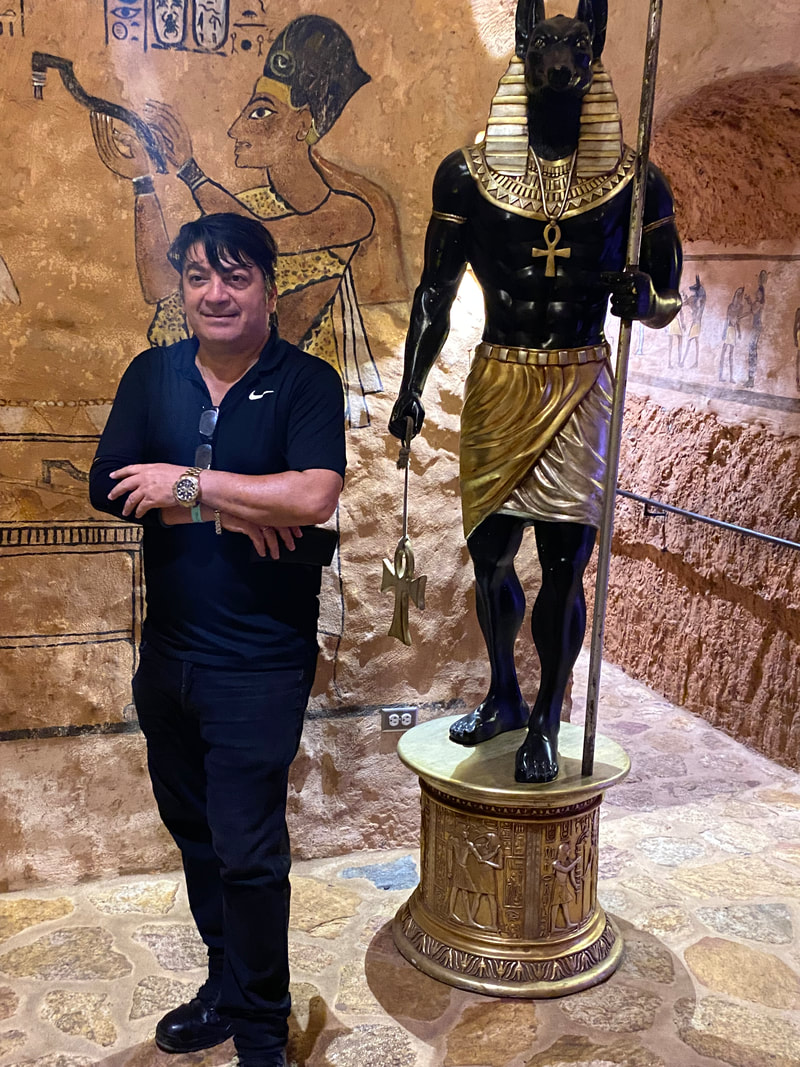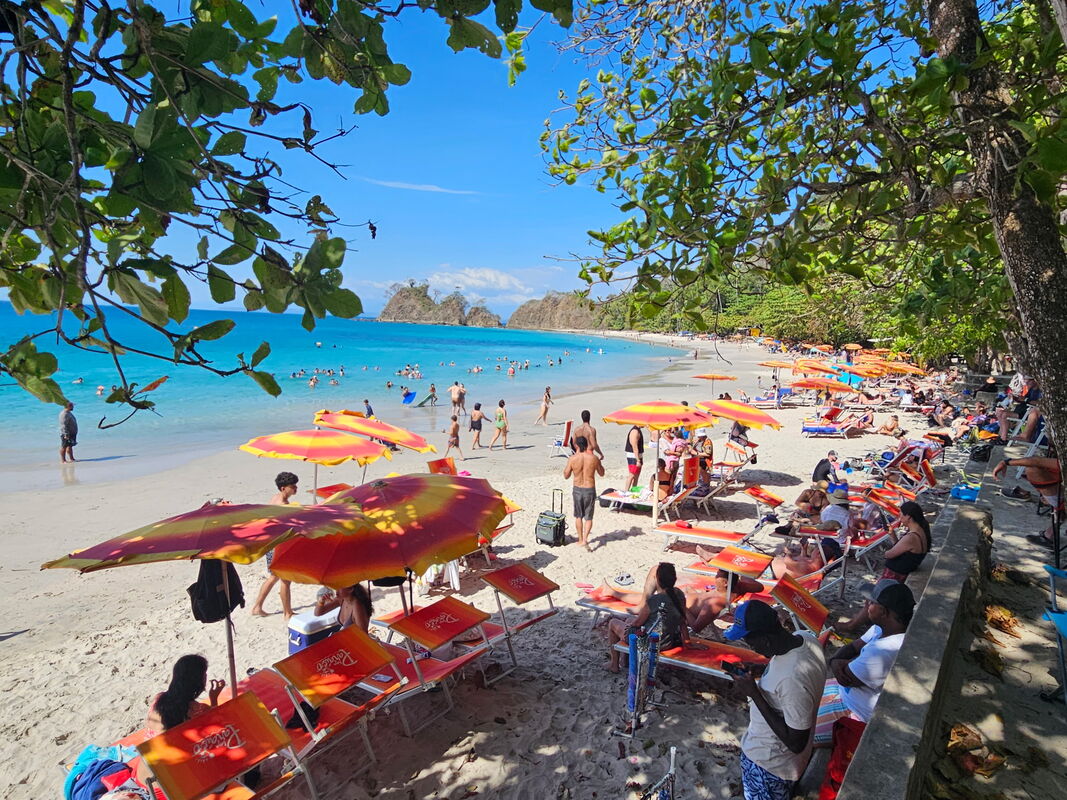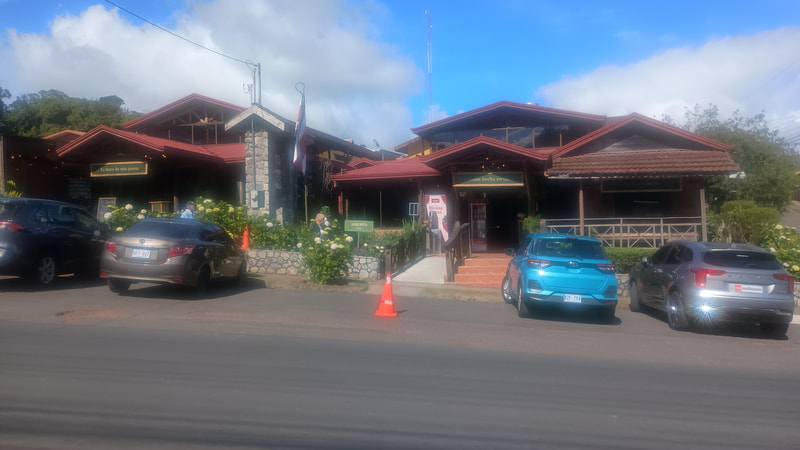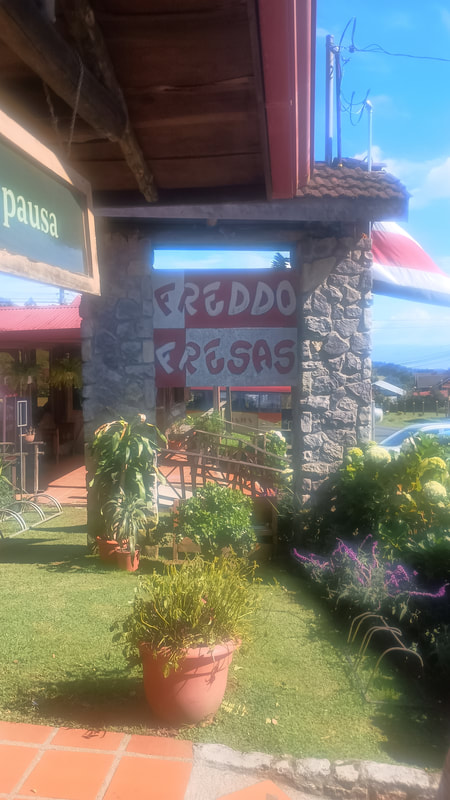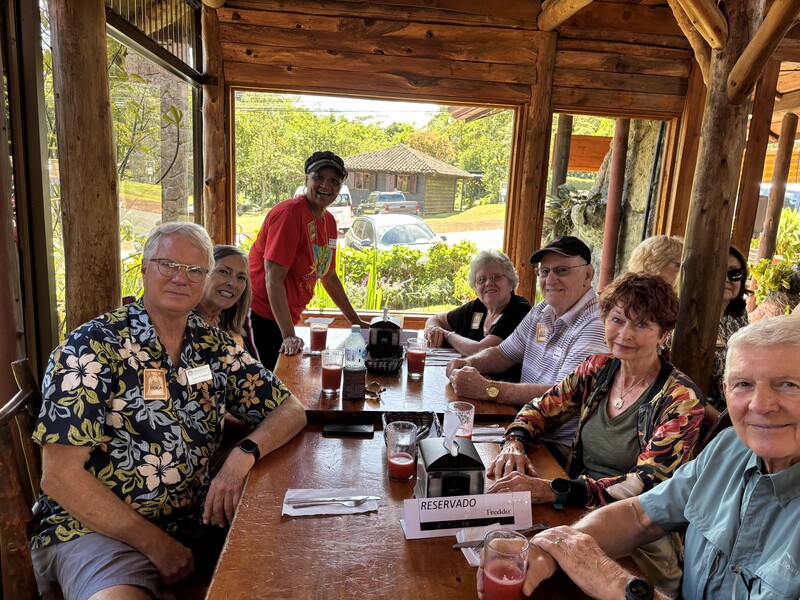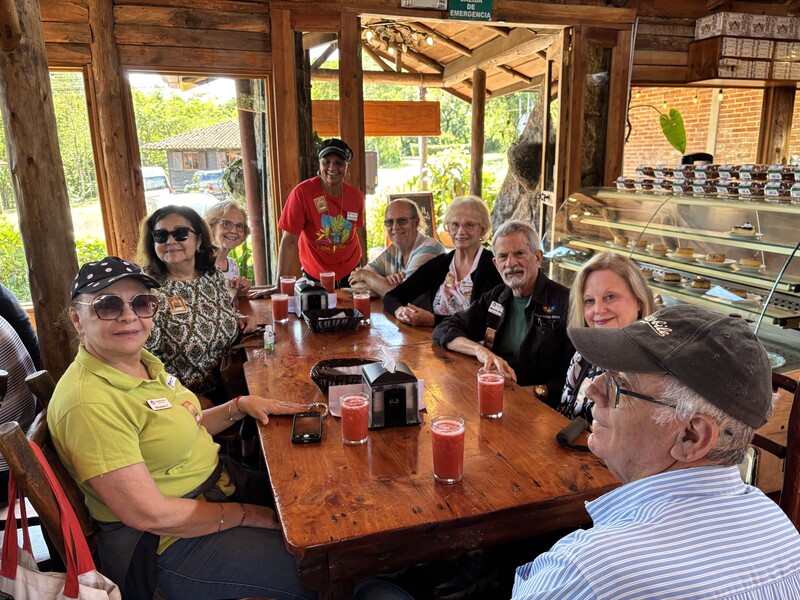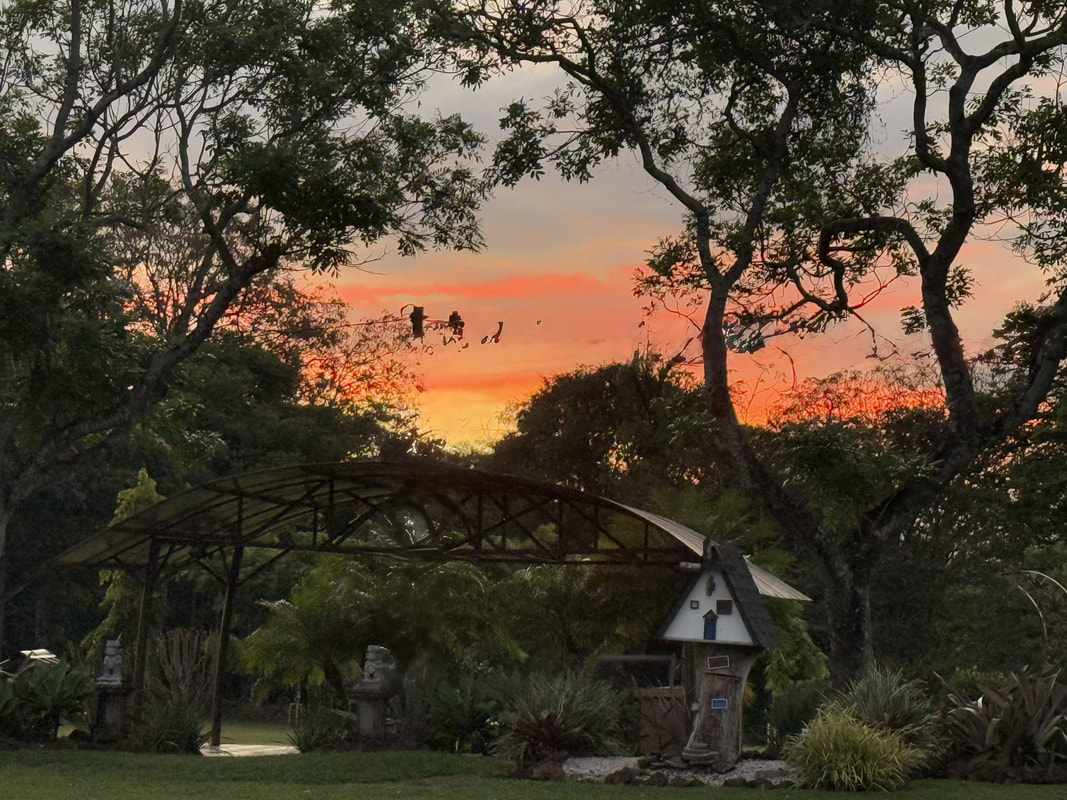Outgoing Journey to Alajuela, Costa Rica #25105- Feb 4-12, 2025
Ambassador Coordinator - Morena Cazedessus Host Coordinator - Ileana Ramirez
To view various slide shows on this page, (1) hover the cursor over the main picture on the left and click on Play/Pause button or Direction Arrows or (2) scroll and click any photo in the thumbnails to the right.
Arrival
On Tuesday, February 4, 2025, sixteen ambassadors from Friendship Force of Baton Rouge traveled to the Alajuela region of Costa Rica. Led by Co-Journey Coordinators, Morena Cazedessus and Lynn Robbins, the other travelers were LaDeta Crawley, Sherry and Tony Dodson, Dean Kopfler, Trudy Ivy, JiJi and Larry Jonas, Karen Pharis, Chris Pomfret, Barbara Simmons, Karen and Art Vingiello, Morris Welch, and Mike Wyble. Most of us were greeted at the San Jose airport by our hosts and taken to their homes. Three families hosting four of us were treated to a great dinner at one of the homes which had a covered outdoor dining area and an extensive garden of large plants with intertwining walkways and a windmill replica at the far end.
Day 1
On Wednesday, February 5, our bus took us first to the Trapiche Hermanos Arias (artisan sugar mill) which has been operating in a small district outside San Ramon called La Paz for over 60 years. This family-run operation turns sugar cane into what is called tapa de dulce which is like a Mexican piloncillo but with a distinctly Costa Rican flavor. A trapiche is a mill made of wooden rollers used to extract juice from fruit, originally olives, and since the Middle Ages, sugar cane as well. Very few trapiches are still working in Costa Rica and this is the only one in the greater South-Central Valley. This mill uses no power machinery except for a small electric motorized grinder. Otherwise, the sugar cane is grown, cut, and processed entirely by hand.
The tapa de dulce is like a brown sugar block used to make agua dulce (sweet water), agua de sapo (sweetened ginger and lime tea) and lots of different candies. To make it, the juice first is extracted from the sugar cane. Next, the juice is sent to boil into caramel water which is then sent to a trough and mixed with a wooden paddle to thicken it. Some of the thick mixture is put on a wooden table and mixed into a sobado candy that is widely popular in Costa Rica and which we sampled. The rest of the mixture is poured into the tapa de dulce molds and left to cool. Once the molds cool, the tapas are removed and packaged for sale.
The tour ended with a tour of the farm and surrounding area by tractor-pulled wagon.
(Wednesday narratives by Art Vingiello.)
The tapa de dulce is like a brown sugar block used to make agua dulce (sweet water), agua de sapo (sweetened ginger and lime tea) and lots of different candies. To make it, the juice first is extracted from the sugar cane. Next, the juice is sent to boil into caramel water which is then sent to a trough and mixed with a wooden paddle to thicken it. Some of the thick mixture is put on a wooden table and mixed into a sobado candy that is widely popular in Costa Rica and which we sampled. The rest of the mixture is poured into the tapa de dulce molds and left to cool. Once the molds cool, the tapas are removed and packaged for sale.
The tour ended with a tour of the farm and surrounding area by tractor-pulled wagon.
(Wednesday narratives by Art Vingiello.)
Next, we traveled to the Else Kientzler Gardens for a traditional Costa Rican lunch of fish, chicken or beef with many vegetables followed by self-guided tours of the gardens. Located on the grounds of an ornamental flower farm on the outskirts of Sarchí, these are extensive, impressive, and lovingly laid-out botanical gardens. Over 1.5 miles of trails run through more than 2,000 species of flora. All the plants are labeled with their Latin names, with some further explanations around the grounds in both English and Spanish. On the grounds are a topiary labyrinth, as well as a variety of lookouts, gazebos, and shady benches. The gardens were created in 2006 by Ludwig Kientzler III for educational and environmental conservation in recognition of the work of his mother Else Kientzler who passed away in 2010.
Our final stop today was the Joaquin Chaverri Oxcart Factory which begin in 1902 in the artisan town of Sarchi. The machinery is run entirely through a series of pulleys, wheels, belts, and handbrakes powered by a small waterwheel using water diverted from an adjacent stream.
Nearby farms have been producing some of the country’s best coffee beans for over 100 years and the demand for oxen-pulled carts was born of the need for a sturdy way to transport this precious cargo to coastal ports. Spanish colonizers brought oxcarts for transportation and farm work but the original European design of spoked wheels kept getting stuck and breaking in the rugged, muddy terrain. In the mid-19th century, a new design based on the indigenous Aztec disc was incorporated into a solid wood wheel bound by a metal ring that could cut through mud without getting stuck.
The earliest oxcarts in Costa Rica were simple and functional plain wood. The tradition of painting and decorating oxcarts started at the Chaverri factory. The story handed down in the Chaverri family says that Joaquin decided to beautify his oxcart to take his family on Sunday outings and painted his first oxcart bright orange which was the only color he had available. Orange and red have since become the most traditional colors for cart painting. Joaquin used powdered pigment mixed with linseed oil to deeply soak into the wood, making it more durable and long-lasting. He also wanted the designs to be different from any other kind of art at the time. Not having any ready-made brushes, he fashioned them from dogs’ hair. Designs and colors are based on Costa Rican plants and flowers. Curlicues, for instance, are modeled after chayote (squash) and ayote (pumpkin) vines and iconic star shapes on wheels were inspired by spear tips.
Once the cart became a source of pride for people, greater care was taken when crafting them, like selecting the highest-quality wood. Eventually, contests were held to award the “most creative and inspiring oxcart designs,” a practice that continues today.
Nearby farms have been producing some of the country’s best coffee beans for over 100 years and the demand for oxen-pulled carts was born of the need for a sturdy way to transport this precious cargo to coastal ports. Spanish colonizers brought oxcarts for transportation and farm work but the original European design of spoked wheels kept getting stuck and breaking in the rugged, muddy terrain. In the mid-19th century, a new design based on the indigenous Aztec disc was incorporated into a solid wood wheel bound by a metal ring that could cut through mud without getting stuck.
The earliest oxcarts in Costa Rica were simple and functional plain wood. The tradition of painting and decorating oxcarts started at the Chaverri factory. The story handed down in the Chaverri family says that Joaquin decided to beautify his oxcart to take his family on Sunday outings and painted his first oxcart bright orange which was the only color he had available. Orange and red have since become the most traditional colors for cart painting. Joaquin used powdered pigment mixed with linseed oil to deeply soak into the wood, making it more durable and long-lasting. He also wanted the designs to be different from any other kind of art at the time. Not having any ready-made brushes, he fashioned them from dogs’ hair. Designs and colors are based on Costa Rican plants and flowers. Curlicues, for instance, are modeled after chayote (squash) and ayote (pumpkin) vines and iconic star shapes on wheels were inspired by spear tips.
Once the cart became a source of pride for people, greater care was taken when crafting them, like selecting the highest-quality wood. Eventually, contests were held to award the “most creative and inspiring oxcart designs,” a practice that continues today.
On the way back to Alajuela, we stopped briefly at a park to take a group picture with a very large cart and to see some nearby churches. Our day ended with a welcome reception at the home of Ileana and Arturo Sanchez where hosts and guests mingled before, during and after our meal of assorted Costa Rican foods and deserts. “Happy Birthday” was sung to our Birthday Boy, Larry Jonas, in both English and Spanish.
Day 2
Our first stop on Thursday, February 6, was La Paz Nature Park and Wildlife Refuge which included beautiful habitats for ten animal exhibits of a variety of wild birds, butterflies, snakes and exotic animals. All of the animals have been rescued for one reason or another and are released back into their wild environment after rehabilitation if possible. The bird and butterfly exhibits were large enclosures that we could actually enter and observe the many varieties of tropical birds, butterflies and hummingbirds buzzing around us, their feeders and the trees. Include were rare hummingbirds and also the largest and smallest varieties of hummingbirds. We also saw parrots, Toucans, and other tropical birds. There was an interesting exhibit of snakes from large to small in their cages, sloths in trees, and several varieties of jungle cats and monkeys. We then stopped for a buffet lunch in the restaurant at the end of the animal exhibits.
(Thursday narratives by Tony Dodson and Trudy Ivy.)
(Thursday narratives by Tony Dodson and Trudy Ivy.)
After a buffet lunch at a restaurant in the middle of the site, we began our walk down to see the other main attraction with was several tall spectacular waterfalls along the La Paz River in a jungle-like setting. Paved sloped walkways with wooden stairways and handrails where needed meant that we definitely got our steps in today. Each waterfall had a platform or other area to get the best view. While Costa Rica is basically in a rain forest, we visited during their short relatively dry season, so this was the only time that we saw rain. We were briefly soaked both by the rain and the spray from the falls. Although several of us brought rain jackets and others purchased ponchos with “Pura Vida” on them, we still got wet. Pura Vida means pure life in Spanish and the phrase encapsulates the culture of Costa Rica.
We took several group photos at the tallest falls but not everyone was together. The area is so green with lush vegetation. At the end of the trail we waited for a bus to take us back to the reception area. Several of us talked to other tourists about Friendship Force while we were there, and as an act of friendship, we gave one young traveling couple a ride back to Alajuela.
We took several group photos at the tallest falls but not everyone was together. The area is so green with lush vegetation. At the end of the trail we waited for a bus to take us back to the reception area. Several of us talked to other tourists about Friendship Force while we were there, and as an act of friendship, we gave one young traveling couple a ride back to Alajuela.
Day 3
The first visit on Friday, February 7, was to Lankester Gardens which was founded in 1940 by Charles H. Lankester and is located on 27.2 acres outside of Cartago. Its mission is to “promote conservation, enjoyment and sustainable use of the epiphytic flora through scientific research, horticulture, and environmental education.” It contains over 3000 species of plants, principally epiphytes, including orchids and bromeliads and the only Japanese Garden in Costa Rica which was donated by the Japanese Government in 2009.
(Friday narratives by LaDeta Crawley.)
(Friday narratives by LaDeta Crawley.)
That was followed by a very scenic drive above the Orosi Valley, stopping to enjoy a panoramic view. Orosi is one of the oldest communities in Costa Rica is in a deep valley with a humid climate surrounded by hills and lush vegetation in which the cultivation of coffee is the leading industry. We then enjoyed a wonderful lunch at La Casona del Cafetal which sits on a hill above the beautiful Cachi Lake. Memorable beverages served were Soursop Punch and personal drip coffee at the table.
Our last stop for the day was the Basilica of Our Lady of the Angels which was built in 1639 and consecrated to the Virgin of Nuestra Señora de los Angeles. Local legend says this all came about when a small statute of Virgin Mary holding baby Jesus was found by a young girl in the city of Cartago. The girl took the statue from the rock on which she found it and brought it home. But when she awoke the next morning, the statue was gone and was back where she had found it. The girl then took the statue to a local priest who locked it up for the night. The next morning the statue was again back on the rock. As the Basilica was being built in another location, various earthquakes led construction to a halt. Construction was then moved to where the statue was found in Cartago. After an earthquake destroyed parts of it, the basilica has been redesigned.
Day 4
For Saturday, February 8, we first traveled on a long bus ride through a variety of landscapes including cattle country in the Sarapiqui region of Costa Rica to visit the Tirimbina Research Station/Eco-Lodge which neighbors the Tirimbina River and is in the heart of a rainforest with lush vegetation, remarkable scenery and diverse wildlife. The station is committed to promoting sustainable tourism and environmental conservation. Led by Walter Lobo, our walking tour began with a gentle downward slope to a very long (and hopefully sturdy) suspension walking bridge above the Tirimbina River with adventuresome kayakers and rafters below. From among several major paths, one of he shorter ones (Ceiba) of about 2300 feet was chosen. But shorter does not mean easy as the surface was at often uneven and (of course) what goes down will later go up. One major site along the walk was a huge rainforest tree called Kapok (Tree of Life--home and source of life for many life forms) which is over 165 ft tall and much wider than the 6.5 feet wide written description. Some of us had hoped to see more wildlife, but we saw some animals including a snake, lizard, fleeting birds and an iguana hiding in the vegetation near the end of the long suspension bridge (waiting to attack some unsuspecting Friendship Force tourist?) (Saturday morning narrative by Larry Jonas.)
We next drove to the Finca Paraiso Organico, an organic pineapple farm near Sarapiqui, for lunch and a tour. It is an eco-friendly family endeavor born of the belief that organic farming is the future for humanity because it is the way to sustain life. It strives to expand organic practices to other local crops such as cassava, line, guanabana, and tantalizing spices and to bring more employment to the community. For the tour, it was relaxing to be seated in an open-air wagon pulled by a tractor and feel the cool breeze while viewing the beautiful farm and learning so many interesting facts about pineapples from our tour guide who was excellent and had a great sense of humor!
Growing pineapples begins with preparing the ground in furrows and covering it with black plastic sheeting. in which holes are later punched to insert seeding. It takes several years for the plant to be large and ripe enough for harvesting which occurs continuously year-round because of the relatively constant climate. In addition to a detailed description of the process of growing and harvesting, many of us especially liked the practical information about how to select a pineapple in the grocery store and prepare it at home. Most of us thought the best way to select a pineapple was by a yellow color and pineapple smell, but now learned that pineapples do not ripen any more after being picked. The yellow color and smell are the beginning of fermentation. It is best to buy pineapples as soon as they are put out in the store. Our guide demonstrated cutting the pineapple with a machete, unlike what we do at home, but it was fun to watch. Tasting a pineapple fresh from the field was a one-of-a-kind experience. Much of the pineapple from this farm is sold to Costco and marketed as frozen pineapple. We learned that our tractor driver’s birthday was this day, so we all kicked in money to give him as a present. Ending the tour with a delicious pina colada was ‘icing on the cake’. It was overall a fantastic experience! (Saturday afternoon narratives by Lynn Robbins and Dean Kopfler.)
Growing pineapples begins with preparing the ground in furrows and covering it with black plastic sheeting. in which holes are later punched to insert seeding. It takes several years for the plant to be large and ripe enough for harvesting which occurs continuously year-round because of the relatively constant climate. In addition to a detailed description of the process of growing and harvesting, many of us especially liked the practical information about how to select a pineapple in the grocery store and prepare it at home. Most of us thought the best way to select a pineapple was by a yellow color and pineapple smell, but now learned that pineapples do not ripen any more after being picked. The yellow color and smell are the beginning of fermentation. It is best to buy pineapples as soon as they are put out in the store. Our guide demonstrated cutting the pineapple with a machete, unlike what we do at home, but it was fun to watch. Tasting a pineapple fresh from the field was a one-of-a-kind experience. Much of the pineapple from this farm is sold to Costco and marketed as frozen pineapple. We learned that our tractor driver’s birthday was this day, so we all kicked in money to give him as a present. Ending the tour with a delicious pina colada was ‘icing on the cake’. It was overall a fantastic experience! (Saturday afternoon narratives by Lynn Robbins and Dean Kopfler.)
Day 5
Traditionally in Costa Rica, Sunday is a Family Day dedicated to building family relationships by doing things together. In that light, it was fitting that Sunday was left open as a free day where ambassadors and their host families could choose activities separately from the organized group whether it be shopping, other activities, visiting other sites or simply resting. Trudy Ivy and Mike Wyble were taken by their hosts, Walter and Yelena Lobo, to the Villa Amphitheater, an old quarry on the edge of a canyon where a man from Belgium created a venue with tropical gardens, trails, viewpoints and replicas of famous sculptures including The Thinker, The Kiss, the Trevi Fountain and statues from King Tut. The guide took them underground through a medieval-style chapel and several rooms. After the tour they drank a Costa Rican cerveza, went to Black Tap restaurant to enjoy steaks, stopped by a grocery market, took an afternoon nap, and woke up to watch the Super Bowl in Spanish while eating guacamole and chicken wings.
Sherry and Tony Dodson and their hosts, Juan Luis Delgado and Angela Castillo, had a very relaxing day on a private beach. Morena Cazedessus and Karen Pharis went to the mountain home of their hosts Noe' Morales and Xinia Villalobos where they enjoyed beautiful mountain views and to the town of Zarcero where they visited a church, Parroquia San Rafael Arcangel Zarcero, and the adjacent park area and lunch. Hosts Mario and Marielos Calderon took Morris Welch to a membership "spa" which actually was a large outdoor recreation area with multiple swimming pools, hot tubs, pool tables, sauna, weight room, ball fields, snack bars, and many small shelters with picnic tables for family groups. On a bright sunny weekend, it swarmed with people but was so spacious that it did not seem overcrowded. Lunch followed in an open-air restaurant that actually had a separate menu in English (probably for tourists). A manager even stopped for a short conversation in English with the American visitor. (Sunday narratives by Mike Wyble and Morris Welch.)
Sherry and Tony Dodson and their hosts, Juan Luis Delgado and Angela Castillo, had a very relaxing day on a private beach. Morena Cazedessus and Karen Pharis went to the mountain home of their hosts Noe' Morales and Xinia Villalobos where they enjoyed beautiful mountain views and to the town of Zarcero where they visited a church, Parroquia San Rafael Arcangel Zarcero, and the adjacent park area and lunch. Hosts Mario and Marielos Calderon took Morris Welch to a membership "spa" which actually was a large outdoor recreation area with multiple swimming pools, hot tubs, pool tables, sauna, weight room, ball fields, snack bars, and many small shelters with picnic tables for family groups. On a bright sunny weekend, it swarmed with people but was so spacious that it did not seem overcrowded. Lunch followed in an open-air restaurant that actually had a separate menu in English (probably for tourists). A manager even stopped for a short conversation in English with the American visitor. (Sunday narratives by Mike Wyble and Morris Welch.)
Day 6
Most of us got up at 3.30 am on Monday, February 10, to rendezvous at 5 am with the bus, ably driven by Wilson, who was our driver for every day except Sunday. A 90-minute ride to Puntarenas on the Pacific Coast, a 1-hour unglamorous car ferry across the Gulf of Nicoya to Paquera, and a final very short drive brought us to O'Pacific Boutique Hotel, a nice beach resort hotel, where we spent most of the day just relaxing after the extensive trips around the country in the days prior. We were greeted with fresh fruit and a fruity drink before most of us donned swimwear and found a place to chill on a perfect weather day. The bar was open whenever we wanted a real drink and we all got together for a lovely sit-down lunch (fried fish with fries, shrimp in rice, or chicken and rice). After lunch, some continued to just chill while others tested the warm waters of the sea on the fine pebbly beach or hung out in the inviting pool and just chat as one does on vacation!
More food and drink appeared at 3 pm (ham and cheese toasted sandwiches, along with something sweet that was local, and hot tea, coffee or iced tea). We were back at the ferry terminal for the 4:30 departure on a much higher quality vessel than the morning’s ride, followed by the bus ride home from Puntarenas. Given that it was early evening already, we decided to relieve our home hosts of fixing food and stopped at a restaurant in Caldera where, just for a change, we ate more food! Arriving at the drop-off point around 9pm, we were either met by our home hosts or taken home by day hosts who filled their cars with ambassadors who lived n the same area. It was a long 19-hour day, but it was unique in that the content was just a day at the beach instead of guided tours of the sights and sounds of Costa Rica. (Monday narrative by Chris Pomfret.)
More food and drink appeared at 3 pm (ham and cheese toasted sandwiches, along with something sweet that was local, and hot tea, coffee or iced tea). We were back at the ferry terminal for the 4:30 departure on a much higher quality vessel than the morning’s ride, followed by the bus ride home from Puntarenas. Given that it was early evening already, we decided to relieve our home hosts of fixing food and stopped at a restaurant in Caldera where, just for a change, we ate more food! Arriving at the drop-off point around 9pm, we were either met by our home hosts or taken home by day hosts who filled their cars with ambassadors who lived n the same area. It was a long 19-hour day, but it was unique in that the content was just a day at the beach instead of guided tours of the sights and sounds of Costa Rica. (Monday narrative by Chris Pomfret.)
Day 7
Our last day on Tuesday, February 11, started with a bus ride to the Hacienda Doka Coffee Plantation, www.haciendadoka.com. Arriving around 10:30 we spend a little free time before for our 11:00 tour walking around well-manicured beautiful grounds and taking photos next to a Chaverri Cart with yoked oxen. Our walking tour was led by a personable young man who spoke fluent English who was very knowledgeable and responsive to our questions. We began on paved sidewalks through an area of coffee plants in various stages of growth. It takes five years before a plant has beans that will be harvested. The ripened coffee beans are still handpicked by migrant workers who come largely from Nicaragua with their families for the 3-month harvest season. We continued into the factory to observe the beans being washed, sorted, and dried. The guide showed us both the "old" way and the new machinery method, which is still the same process but much quicker. We learned about the entire process from bean (seed) to cup! The tour lasted about an hour and a half and allowed for time in the very nice gift-shop which had plenty of free brewed coffee for tasting and some candy samples. We departed at 1:00 for lunch a little further up the mountain to Freddo Fresas. The restaurant was nice, they were efficient and prepared for us, and the food was good. At my table, 6 of 7 people close the beef "stew" that was very tasty with no additional seasoning needed! (Narrative by Sherry Dodson.)
Lunch at Freddo Fresas
The final event of the journey was a Farewell Party at an event property called Villa del Lago which had just been inherited by a Friendship Force Alajuela member from a brother 3 months before. It was a beautiful area with all species of trees and plants, a lake and a small chapel where weddings are held. We were encouraged to arrive early so we could tour around the area. The party was held in a covered open area with tables with white tablecloths and chairs wrapped in white arranged in angles facing a live band. Each table had a beautiful flower arrangement in the middle of it. The food was catered, consisted of beef with gravy, chicken, rice, veggies and dinner rolls, and was served buffet style. The dessert was a cheese flan. Soft drinks, beer and wine were the drinks of choice. The excellent band was called Las Gross and consisted of mother, father, son and daughter who sang. The music varied from American songs from the 60's up to the present with Latin music played along the way. Both clubs had a great time dancing to the band’s lively music. Everyone had fun when FFBR performed our usual Second Line and gave out beads and masks to our hosts. Each FFBR ambassador was then presented with a personalized Friendship Force mug. (Narrative by JiJi Jonas.)
Departure
|
We awoke on Wednesday, April 12, to a brilliant sunrise as we headed home, probably tired but with grand memories of our visit to Costa Rica, a country of fantastic vistas, hard-working people, and gracious hospitality. Many thanks to our hosts for a great itinerary, the wonderful taste of their culture, the sharing of their home lives, and most of all their kindness and friendship. Pura Vida!
|





